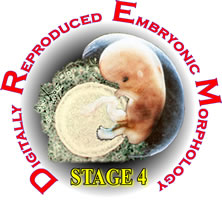

| Rhesus Opening Screen | Embryo C610 Figures | Download Section Images |
| Browse Sections | Flythrough Animations | Help / Instructions |
| 3D-Models | Stage 4 Opening Screen | Credits |
Stage 4 is reserved for the attaching blastocyst that is adhering to the endometrial lining of the uterus. The attaching process is called adplantation and heralds the onset of implantation. Stage 4 embryos have an estimated postfertilization age of approximately 6 days.There are no known in vivo human specimens at stage 4.
IN VIVO RHESUS EMBRYO
The sections of an in vivo rhesus monkey (Macaca mulatta) embryo are presented in the database. [Note: The sections of this embryo are no longer located in the Carnegie collection. The images presented here were adapted from a set of bromide prints in the collection.]
The rhesus specimen (#C 610) was prepared for microscopic examination ca. 1939, and has been given a grade of excellent. The size of the blastocyst before sectioning was 0.42 x 0.34 mm. It was fixed in Bouin's solution, embedded in celloidin and parafin and serially sectioned at 6 microns (Heuser & Streeter, 1941). There are 55 sections through the blastocyst and adjacent endometrial tissue. Structures are identified on every section image.
The outer trophoblast layer of the hatched blastocyst has multiple areas of attachment to the endometrial epithelium (click here for reconstructions of the attachment site ). In the areas of contact the syncytiotrophoblast dissolves the endometrial epithelium. The epithelial cytoplasm disappears before the nuclei, resulting in an accumulation of nuclei in these areas. Progressive differentiation of the trophoblast is taking place. The cytotrophoblast becomes distinct from the overlying syncytiotrophoblast. Amniogenic cells are separating from the trophoblast and are distinct from the inner cell mass. The hypoblast layer is a distinct, thin layer on the underside of the inner cell mass. The remaining cells constitute the epiblast.
Specimen #C 610 was described previously by C.H. Heuser and G.L. Streeter (1941) and the figures from their paper are reproduced here. The serial bromide prints have been digitally restored, colored, and labeled, and can be viewed at three magnifications. Several 3D reconstructions have been produced from the aligned sections. Animations of the 3D reconstructions and flythrough animations of the aligned sections are also included on the disk. For anyone who wishes to use them for other reconstructions, research or presentations, all of the original section images are available as individual .jpg files or as zip files.
Instructions for using the disks can be found by going to the Instructions section from the opening screen.
![]()
Heuser, C. H., and Streeter, G. L. (1941) Development of the macaque embryo. Carnegie Instn. Wash. Publ. 525, Contrib. Embryol. 29:15-55.